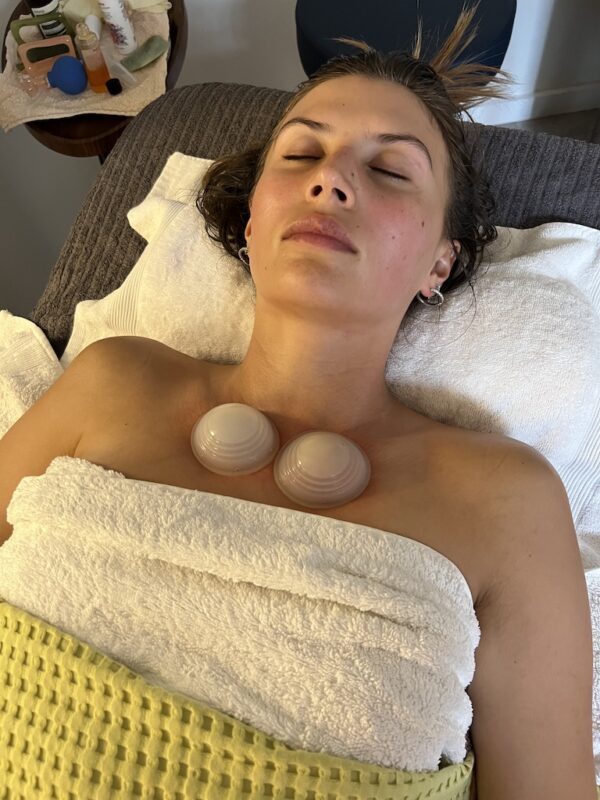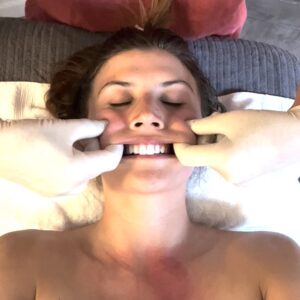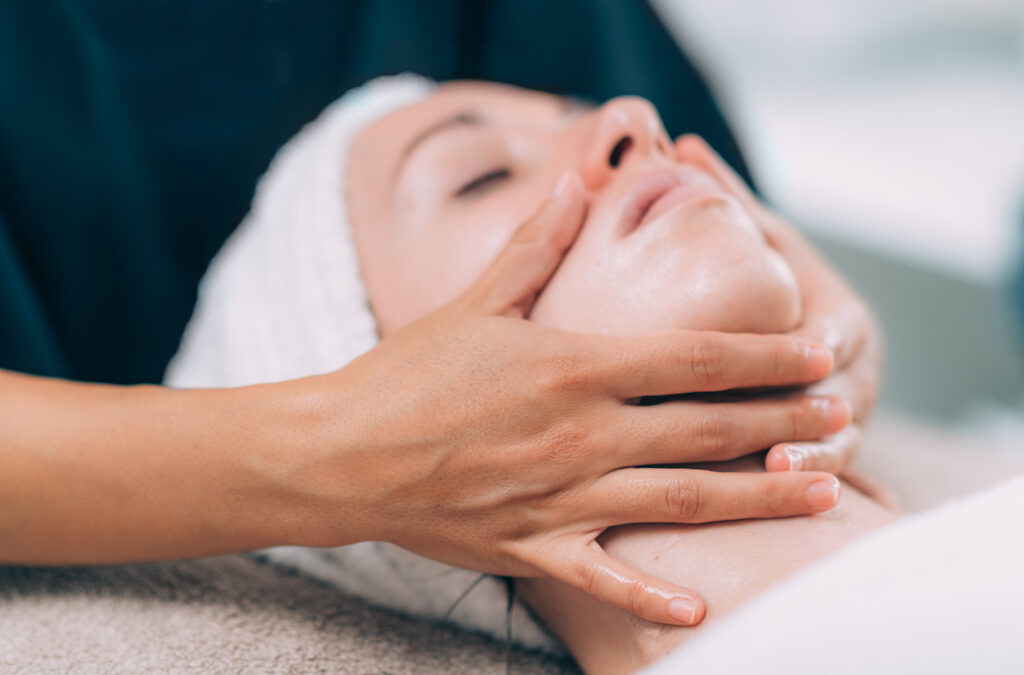Achieve a Natural Face Lift with Facial Sculpting and Buccal Massage
Do you want a more natural way to achieve a more toned and lifted face? This specialised facial massage targets the muscles and tissues in your neck, face, and upper chest. It uses unique techniques, both inside and outside your mouth, to release deep tension and stress that can contribute to wrinkles and sagging.
The result? A sculpted and rejuvenated appearance.
Meghan Markle, Jennifer Lopez and Kate Moss are buccal massage fans!
Facial Sculpting & Buccal Massage Trio: A Relaxing and Restorative Experience
This treatment goes beyond just sculpting your face. It provides a holistic experience designed to promote relaxation and improve your overall well-being. Here’s what we do:
- Breathwork for Deep Relaxation: We begin with deep breathing exercises to help you unwind and prepare your body for the treatment.
- Lymphatic Drainage for Detoxification: Specific techniques stimulate the lymphatic system to drain fluids and toxins from your face, neck, chest, and abdomen, promoting detoxification and a brighter complexion.
- Spinal Release for Improved Circulation: Long movements alongside your spine help release tension, and move any neurotoxins in the neurolymphatic system that might be affecting your overall lymphatics.
- Facial Sculpting: This technique improves the tone and elasticity of your facial tissues, leading to visible results that last.
- Buccal Massage for Targeted Tension Relief: We will use gentle massage inside and outside your mouth to help release tension in facial muscles, especially around the jawline. This can also be beneficial for those experiencing teeth grinding (bruxism) or jaw dysfunction (TMJ).
- Deep Scalp Massage for Complete Relaxation: The treatment concludes with a deep scalp massage to release any remaining tension, leaving you feeling completely relaxed and rejuvenated.
What I Love About Facials
I love having facials, but I am not overly fond of all the products that are typically used during a facial. This new treatment uses manual techniques to achieve results.
My recent training
I recently trained in sculptural face lifting techniques and buccal /intra-oral release and loved it – because it taught me new ways of working with the face, neck and décolletage.
Pro-Age Aesthetics and their Neo-lifting course is aimed at beauticians or aestheticians (as they call it in the US) and massage bodyworkers (like myself) that want to advance more natural techniques, to tone the face and neck.
No more Botox for me!
I decided to stop using Botox, and any kind of facial filler /injections, as the results were not very impressive and the cost was high. I wanted to find a way to improve my face naturally. I was also keen to understand the mechanics of the jaw from an intra-oral perspective, rather than just the external approach, of working with TMJ issues as I already do for clients who require it.
Facials and bodywork together
Facials are a wonderful treatment, and I think they are even better with the right kind of bodywork to make the whole treatment more balanced and holistic.
My clients are loving this combination treatment of deep facial work and bodywork.
What to Expect During Facial Sculpting & Buccal Massage
- Your comfort and hygienic safety are our top priorities. We will tailor the treatment to your needs and preferences,
- We will guide you to focus on your breath to promote relaxation and stimulate your parasympathetic nervous system (the “rest and digest” system). The treatment is conducted in a calm and quiet environment.
- The treatment primarily uses hands, for optimal control and are the most sensitive and adaptable tools we have. Pressure will be adjusted based on your needs.
- Depending on your skin and desired outcome, some facial tools may be used.
- This treatment combines facial drainage with “Neolifting” techniques that target deeper fascia layers to release tension and promote a relaxed facial appearance.
- This gentle massage focuses on the buccal area (cheeks) to release tension in muscles like:
– buccinator (used for sucking in cheeks),
– masseter (involved in chewing), - Gentle stretch and manipulation of the Décolletage area refers to the chest (sternum and ribs) and collarbone (clavicle) area (often tightened due to clenched jaw, shoulder tension, posture or breathing habits).
- If you’re Pregnant, we’ll discuss if the treatment is suitable for you at your stage of pregnancy and adjust it accordingly.
- If you’re Postpartum your pelvis naturally realigns itself post birth; and we’ll discuss any specific needs you might have and tailor the treatment accordingly.
- Lymphatic drainage and gentle stretches will help release tension in your neck and upper spine. A deep scalp massage will further promote relaxation and release tension in your head.
- We use facial oils to enhance your treatment and LED light therapy maybe used to reduce any minor inflammation.
Benefits: A Holistic Approach to Rejuvenation
This treatment provides a holistic approach to rejuvenation, promoting both physical and mental well-being:
- Releases deep tension that can contribute to wrinkles and facial aging, creating a more youthful and resting face.
- Lymphatic drainage helps eliminate toxins and improves circulation throughout your body, promoting overall health and a brighter complexion.
- The treatment helps reset the nervous system, promoting relaxation and reducing stress. This is especially beneficial for the vagus nerve, a critical cranial nerve that connects your gut to your brain and plays a vital role in digestion, mood, and overall well-being.
- By manipulating the fascia (connective tissue) throughout your face, neck, and head, the treatment improves its health and function. This can lead to better facial structure and support, potentially contributing to a lifted appearance.
- Buccal massage specifically targets tension in facial muscles, promoting a more relaxed and balanced jawline. This can help alleviate symptoms of TMJ (temporomandibular joint dysfunction) and bruxism (teeth grinding).
What’s the Difference Between our Gua Sha Facial and our Facial Sculpting & Buccal Massage Trio Treatment?
The Gua Sha Facial Treatment:
It includes abdominal lymphatic drainage and feet reflexology and is one of our clients’ favourite treatments. It’s also one of my favourites, because of the deep relaxation clients experience, and from the calming results of the Gua sha tool.
Light facial releases: and the combination of lymphatic facial and abdominal drainage, makes for a whole body and overall, more satisfying treatment.
Light facial cupping for under the eyes: helps to stimulate dark tissue congestion and to move it out of the area. If you leave it alone, it will tend to stay. Rather like a bruise that stays stuck in the superficial layers of the skin, under the eye discolouration needs stimulation (via gentle friction) to bring circulation and oxygen to the area again.
The Facial Sculpting and Buccal Massage:
- It’s a deeper treatment, with more specific and manipulative lifting techniques to restore tone and circulation to the face.
- It’s a facial workout and our new favourite.
- Drainage via the neck, décolletage and side of chest moves away puffiness and congested tissue.
The décolletage or chest area is the foundational template of releasing tension through the ribs and intercostals. It directly connects to the neck muscles stimulating tone. And deepens our breath awareness to the rest of our body.
Facial and décolletage tools are used: depending on the client’s skin and desired results.
The jaw and neck are the cornerstones of the face to redefine the shape and special emphasis is done here. Buccal or intra-oral release gently works on sensitive layers of tissue from inside the mouth and to stretch and release around the mouth and into the jaw and cheek areas.
Also recommended for: bruxism (teeth grinding) and TMJ issues giving a deep relaxation of the face and body. Again, lymphatic abdominal drainage and spinal work is included to make a whole treatment more restorative.
Including Cranial Nerves Briefly:
Cranial nerves are like special messengers that carry signals between your brain and various parts of your head and neck, including your facial muscles. This treatment can influence these nerves (including the vagus nerve) by promoting relaxation and improved circulation, potentially leading to better overall function.
Book your treatment
Schedule Your ‘Facial Sculpting & Buccal Massage Trio’ Deluxe Treatment Now!
How the Lymphatic System is Complementary to the Circulatory System?

THP Client receiving a Buccal Release massage with Cupping therapy
- Lymphatic drainage moves wastes from your circulatory system into the bloodstream. It also drains into the great neck veins, the thoracic duct and the right lymphatic duct just beneath the clavicle (collarbone).
- These are the areas where a good décolletage drainage is given, draining and increasing the circulation in your overall systems
- Your diaphragm and lungs (circulatory system again) are exercised in a comfortable lying down (supine) position.
- Fluid that is moved out of the bloodstream during normal circulation is filtered through lymph nodes to remove bacteria, abnormal cells and other matter. This fluid is then transported back into the bloodstream via the lymph vessels.
- Generally speaking, if your circulatory system is functioning well, then so should your lymphatic system.
- However, when illness enters the body and is sustained for any length of time, then the immune system and the lymphatic system can be compromised.
Therefore activity to mobilise the body is important and to reduce triggers and stressors that impact on the various systems.

A female client receiving part of the Buccal Facial Massage on the interior of her mouth and cheeks with the therapists gloved hands at The Healing Practice
What products do I use for your treatment?
- I am very fond of Living Libations (a Canadian company that makes exquisite facial oils and a huge range of other products too)
- Ritual Moringa facial oil
Who cannot be Treated?
- Please stay home if you are sick especially with a respiratory condition
- You have an inflamed facial condition
- Had Botox or other facial injectables in the last 2 weeks
How to pronounce Buccal (in case you’re interested?)
The proper pronunciation is like: buckle with a softer sound on the c and a slight pause before you say the c. Bu-ccal. Its origin is Latin and means cheek.
Book your treatment
Schedule Your ‘Facial Sculpting & Buccal Massage Trio’ Deluxe Treatment Now!
Concession rates available
Health Fund Rebates available
Gift Certificates are available
7 Albert Street, Forest Lodge ( Glebe) NSW 2037
Claire [@] The Healing Practice.com.au
M: 0438 216 351

